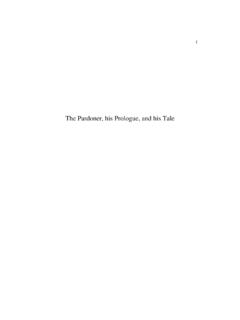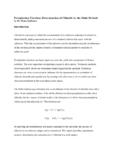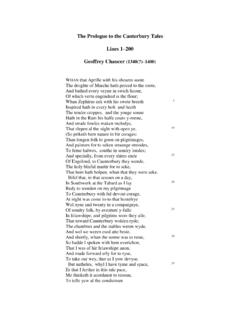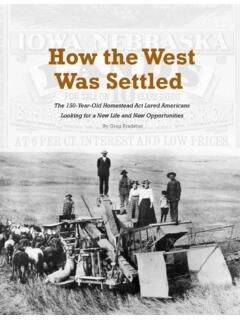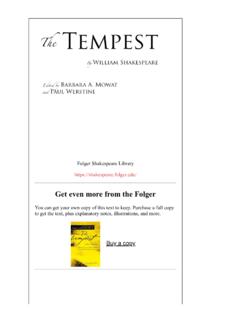Transcription of The Canterbury Tales - City University of New York
1 1 The Canterbury TalesThe wife of bath and her Tale2 The wife Of bath s Tale Introduction We remember the wife of bath , not so much for her tale as for Chaucer's accountof her in the General prologue and, above all, for her own prologue . For one thing,the tale itself is a rather unremarkable folktale with a lecture on true nobilitysomewhat awkwardly incorporated. The tale is meant to illustrate the contentionof her prologue : that a marriage in which the woman has the mastery is the best,and the conclusion of one closely coincides with the other. The tale also seems toexpress covertly her desire to be young and beautiful again. It is not a poor tale,but neither is it of unforgettable force like the Pardoner's or of unforgettablehumor like the Miller's. Moreover, the prologue is about three times as long as thetale to which it is supposed to be a short introduction. If that is appropriate foranyone, it is so for Alison of bath , about whom everything is large to the point ofexaggeration: her bulk, her clothes, her mouth, the number of her marriages, theextent of her travels, her zest for sex, her love of domination, her torrentialdelivery.
2 The result is a portrait of someone for whom it is difficult to find ananalogy in English literature except perhaps Shakespeare's Falstaff or some of thecharacters of Dickens. She is wonderful company provided one is not married to her and can contemplatefrom a distance the fate of the sixth husband whom she is seeking as voraciously asshe did his predecessors: "Welcome the sixth, when that ever he shall." Shall what? Have the temerity to get too close to this medieval Venus Flytrap, and bedevoured? Oddly enough, this unforgettably ebullient figure is an amalgam of many featuresderived from Chaucer's reading. Many of the traits he attributes to her areessentially borrowed from that favorite of the Middle Ages, the long French poemThe Romance of the Rose. She also embodies traits in women which misogynisticChurch Fathers like Jerome and Tertullian denounced in their writings. All thisillustrates what wonderfully creative work can be done with old material. Themedievals liked to think that their Tales were not original, that they were renewedversions of old authors who had become "authorities.
3 " Here Chaucer borrowsWIFE OF bath 'S TALE3very freely, and it is interesting to observe the result. While the elements are notoriginal but largely borrowed from a variety of sources, the final product is theunforgettably original creation that is the wife . The wife has attracted attention and comment over the centuries in abundance incontrast to, say, that pleasant and attractive lady, the Prioress. One reason is theintense personal quality that emanates from the character. Take her way ofreferring to herself or to women in general. Whether she is holding forth in herPrologue or telling her Tale, her pronouns slip with an engaging ease from "they"to "we" to "I" or from "women" to "we" to "I" or the other way round. Her talkis intensely hers, incapable of being confused with that of anyone else. As she istelling how she always made provision for another husband if her current victimdied, she loses the thread of her discourse for a second, but only for a second: But now, sir, let me see what shall I sayn?
4 Aha, I have my tale again (585-6). As she is telling her folktale of the knight and the old hag, she refers to theclassical story of Midas, and immediately wants to tell it: Will you hear the tale? (951). Her prologue is, above all, about her her experiences of love in and out ofmarriage, and her right to hold forth on that subject in spite of the "authority" ofclerics who know nothing about the matter. A much-married woman, she hasmuch more "authority" on love and marriage than any celibate clerk who knowsonly books, and she knows how to deal with books that do not please her too. Her outpouring is a confession of sorts but without a trace of the penitent's "meaculpa," for as she recalls with relish: "I have had my world as in my time." Theonly thing she regrets is that age "Hath me bereft my beauty and my pith." Hers is the first contribution to the Marriage Group, and it is answered in one wayor another by the Tales of the Clerk, the Merchant, and the Franklin.
5 She asks herfellow pilgrims to take it "not agrief of what I say / For my intent is not but for toplay " (191-192), but the force of her polemic and her personality has attracted farmore attention from readers early and late than most other characters on thatfamous Tales 1 460: at church door: Weddings took place in the church porch, followed by Mass inside. 4 The Portrait, prologue and Tale of the wife of BathThe portrait of the wife from the General PrologueIn the wife of bath we have one of only three women on the pilgrimage. Unlikethe other two she is not a nun, but a much-married woman, a widow yet again. Everything about her is exaggerated: she has been married five times, has been toJerusalem three times, and her hat and hips are as large as her sexual appetiteand her love of good wife was there of besid bath near But she was somedeal deaf, and that was scath. somewhat / a pity Her coverchiefs full fin were of ground; finely woven I durst swear they weigh den ten pound dare That on a Sunday were upon her head.
6 Her hosen weren of fine scarlet red stockings Full straight y-tied, and shoes full moist and new. supple Bold was her face and fair and red of hue. color She was a worthy woman all her life. 460 Husbands at church door she had had five,1 Withouten other company in youth, Not counting But thereof needeth not to speak as nouth. now wife OF bath 'S TALE5 1 467: Chaucer does not explain, and the reader is probably not expected to ask, how theWife managed to marry five husbands and take in pilgrimage as almost another occupation. Going to Jerusalem from England three times was an extraordinary feat in the Middle Ages. This list is, like some others in the prologue , a deliberate exaggeration, as is everything elseabout the wife . 2 470: A wimple was a woman's cloth headgear covering the ears, the neck and the chin. 3 476 : She knew all about that. And thrice had she been at Jerusalem. 3 times She had pass d many a strang stream. foreign At Rom she had been and at Boulogne, In Galicia at St James and at Cologne.
7 [famous shrines] She could much of wandering by the knew much Gat-tooth d was she, soothly for to say. Gap-toothed / truly Upon an ambler easily she sat slow horse 470Y-wimpled well,2 and on her head a hat As broad as is a buckler or a targe, kinds of shield A foot mantle about her hippes large, outer skirt And on her feet a pair of spurs sharp. In fellowship well could she laugh and carp. joke Of remedies of love she knew perchance by experience For she could of that art the old dance. 3knewPROLOGUE to the wife OF bath 'S TALE The wife s narrative opens with a defense of her many marriages, all legal, asshe points out, recognized by the Church even though some churchmenfrowned on widows re-marrying. The wife challenges anyone to show her wherethe Scripture sets a limit to the number of successive legal marriages a personcan have in a lifetime. She claims that, because she has lots of experience ofmarriage, she is more of an authority on that subject than the celibate authorities who write about it.
8 And she knows how to use authorities too, ifit comes to it, as the many marginal references in our text , though no authority authors. Canterbury TALES6 1 1-3: "Even if no `authorities' had written on the subject, my own experience is quiteenough for me to speak with authority on the woes of marriage." By authorities she means theBible, theologians and classical authors. 2 4. Lordings means something like "Ladies and gentlemen." Twelve was the legal cononicalage for girls to marry. Marriages took place at the door of the church followed by mass inside. 3 9-13: Jerome, one of the more ascetic of the Church Fathers, suggested that because Jesusis recorded as having attended only one wedding, people should not marry more than once. TheWife scoffs at this peculiar thinking. 4 14-16: "Now listen also to what sharp words Jesus, who is God and man, spoke on oneoccasion (for the nonce) when he reproved the Samaritan woman at the well.
9 " In the Gospel ofJohn (4:4-26) Jesus tells a Samaritan woman whom he meets as she is drawing water from awell, but whom he has not seen before, that she has had five husbands, and that the man she isnow living with is not her husband. He does not say why her present partner is not her husband. Were in this world, is right enough for me To speak of woe that is in marr age;1 For, lordings, since I twelve years was of age,2 5(Thank d be God that is etern alive) Husbands at church door I have had five, (If I so often might have wedded be). And all were worthy men in their degree. But me was told certain not long agone is, (To) me 10 That since that Christ ne went never but once To wedding, in the Cane of Galilee, John II, 1-10 That by the same example taught he me, That I ne should wedded be but Lo, hark eke which a sharp word for the nonce4 15 Beside a well Jesus, God and man, Spoke in reproof of the Samaritan: John IV, 6-26 `Thou hast had fiv husband s,' quod he; said he `And that ilk man which that now hath thee, that very man Is not thy husband.
10 ' Thus he said certain; 20 What that he meant thereby, I cannot sayn. But that I ask why that the fifth man Was no husband to the Samaritan? How many might she have in marr age? wife OF bath 'S TALE7 1 33. "Bigamy" here means being married twice but not to two people at the same time."Octogamy" = 8 marriages in a row. Later, however, the wife seems to use the term "bigamy" inthe sense of the sin or crime of bigamy ( ). 2 39: This line means either that the gift was from God to him in granting him so manywives, or from Solomon to them, probably the former. 3 44a-44f: The following six lines do not appear in any Six Text MS, but they have beenaccepted by scholars as genuine Chaucer, and appear in many editions. 44a Of which I have pick d out the best Both of their nether purse and of their purse = scrotum Div rs school s maken perfect clerks students And d verse practices in sundry works Maken the workman perfect sikerly. Yet heard I never tellen in mine age my life 25 Upon this number definit on; Men may divine and glossen up and down.

